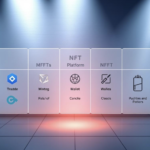Now Reading: Discover How to Provide Liquidity on Decentralized Exchanges
- 01
Discover How to Provide Liquidity on Decentralized Exchanges
Discover How to Provide Liquidity on Decentralized Exchanges

This guide aims to show users clear steps for supplying assets, what to prepare, and how to manage positions over time. It is a practical road map for U.S. participants in the defi ecosystem who want plain rules and realistic expectations.
Liquidity matters in crypto trading because it affects execution quality and slippage. Healthy markets rely on deep pools that let trades clear quickly and keep fees fair for users and traders alike.
A liquidity pool is a crowdsourced set of tokens locked in a smart contract. Automated market makers (AMMs) use these pools instead of traditional market makers, enabling continuous swapping without matching buyers and sellers.
LP tokens represent a depositor’s share and are redeemed to withdraw funds plus accrued trading fees. Expect risks such as impermanent loss, smart contract failure, and market volatility.
What follows: fundamentals of liquidity, AMM mechanics, pool types, setup steps, earnings strategies, and security best practices. Read on for actionable steps that match how modern DEXs actually function.
What Liquidity Means in DeFi and Why It Matters
Liquidity measures how quickly an asset can be traded without shifting its market price. High liquidity supports price stability and keeps slippage low for most orders.
Market value reflects perceived worth but may be hard to realize in a thin market. When depth is shallow, large trades move price and widen the bid-ask spread.
Slippage is the gap between expected and executed price. It grows when available depth is small or during volatile sessions, hurting traders with big orders.

- Order book systems depend on buyers sellers posting bids and asks, which can create wide spreads when depth is low.
- AMMs quote price from on-chain pools, allowing swaps without matching a counterparty.
- Fragmented liquidity means an asset can be liquid on one venue and illiquid on another.
- Understanding these mechanics helps select the right pool or exchange and manage price impact expectations.
| Mechanism | How Price Is Set | Typical Strength |
|---|---|---|
| Order book | Bids and asks posted by traders | Good for deep markets; can gap if depth is low |
| AMM (on-chain) | Pool ratio and formula set price | Continuous swaps; predictable slippage math |
| Hybrid/aggregator | Combines venues, routes orders | Improves fills across fragmented markets |
How Liquidity Pools and AMMs Power Decentralized Exchanges
On-chain pools lock assets in code, creating continuous liquidity that prices against reserve ratios.

Liquidity pools are vaults in smart contracts where users deposit two or more tokens. These reserves enable instant swaps without an order book. The contract records balances and issues LP tokens that represent ownership.
Automated market makers use formulas to set price from pool ratios. The constant product model (x*y = k) shifts price as reserves change, so pools quote continuously even when no trader posts an order.
- Advanced curves, like stable-swap, cut slippage for similarly priced assets.
- Each swap pays a small fee that accrues to the pool and is split pro‑rata among providers.
- Deeper pools lower price impact and can increase fee income when volume rises.
| Feature | Behavior | Impact for LPs |
|---|---|---|
| Constant product | Price set by reserve ratio | Simple, broad markets; higher slippage for large trades |
| Stable-swap curve | Reduced slippage for like assets | Better for stablecoins; lower impermanent loss risk |
| Fee tiers | Variable per protocol and pool | Affects earnings and trade flow |
Types of Liquidity Pools and Where to Provide Liquidity
Design choices in a pool affect capital efficiency and day‑to‑day management needs for LPs. Different models change fee income, slippage, and risk exposure. Below is a concise guide to common pool types and the protocols that host them.

Traditional and Stablecoin Pools
Traditional two‑asset pools pair equal values of each token. They remain the default for many pairs because they are simple and predictable.
Stablecoin pools group tightly pegged assets to cut price impact. Protocols like Curve specialize in this model for low slippage swaps.
Multi‑asset, Single‑sided, and Concentrated Models
Multi‑asset pools hold several tokens with custom weights. Balancer uses this approach to give flexible exposure in one position.
Single‑sided solutions aim to reduce asymmetry and limit impermanent loss. Concentrated liquidity lets LPs focus capital inside chosen price ranges, improving fee efficiency but demanding active management.
Major Protocols and Aggregation
Uniswap offers general AMMs and concentrated liquidity. SushiSwap mirrors classic AMMs with incentive programs. PancakeSwap targets BSC users with similar designs.
DEX aggregators stitch routes across pools and venues to find better fills. Cross‑chain bridges and EVM interoperability are easing fragmentation so liquidity can serve the market where users trade.
| Pool Type | Best For | Trade‑off |
|---|---|---|
| Two‑asset (50/50) | Simple pairs | Predictable, higher impermanent loss for volatile pairs |
| Stablecoin | Fiat‑pegged swaps | Low slippage, lower fees per trade |
| Concentrated | Active fee capture | Higher management burden |
For a broader primer on trading venues and mechanics, see understanding DEX mechanics.
Before You Start: Wallets, Networks, Tokens, and Fees
Begin with a compatible self‑custody wallet and enough native token for gas.
Choose a wallet that supports your target chain and fund it with the chain’s native token. Small balances let you test interactions without risking assets. Verify token contracts from official project docs before approving any spending.

Select network and verify tokens
Pick the correct network (Ethereum, BNB Chain, etc.) to avoid failed transfers or accidental bridging. Research token contracts to avoid impostors and copycats.
Assess pairs, depth, and price impact
Analyze pair depth and historical volume. Deeper pools usually reduce price impact and improve execution quality for traders and LPs.
- Know fee tiers: trading fees vary by pool and affect trader costs and LP revenue.
- Approvals and supplies each incur gas fees; plan for both.
- Test with a small amount, then scale once processes are clear.
| Step | What to Check | Why it Matters |
|---|---|---|
| Wallet funding | Native token balance | Covers gas for approvals and supply actions |
| Token verification | Official contract address | Avoids fraud and fake tokens |
| Pair analysis | Pool depth & volume | Lower price impact and better fees |
For a short primer on pool mechanics, see what is a liquidity pool.
How to provide liquidity on decentralized exchanges
Follow a simple four-step flow that guides selection, funding, monitoring, and exit. These steps keep actions clear and lower common operational errors.
Step one: Select a DEX, a pool, and review pool metrics
Pick a protocol and inspect TVL, recent volume, and fee tier. Check volatility and historical returns to weigh reward versus risk.
Step two: Approve tokens, set amounts, and supply liquidity
Approve each token spend in your wallet, then deposit equal-value amounts unless the pool accepts single‑sided entries. Confirm token contracts before signing any on‑chain transaction.
Step three: Receive LP tokens and track position performance
After deposit you get LP tokens that represent your share. Use the pool dashboard or protocol analytics to watch fees earned, position value, and exposure to price moves.
Step four: Add, rebalance, or remove liquidity and claim fees
Add or rebalance to keep capital effective, especially with concentrated ranges. Remove liquidity by burning LP tokens to reclaim assets and accrued fees. Run a small test transaction first and set reminders to check positions in volatile markets.
| Action | Check | Why |
|---|---|---|
| Pool evaluation | TVL, volume, fee tier | Estimates earnings and slippage |
| Approvals | Token contract & gas | Prevents fraud and failed tx |
| Monitoring | Fees, value, range | Informs rebalancing or exit |
Earnings, Fees, and Yield Strategies for Liquidity Providers
LP income blends trading fees, reward tokens, and optional staking payouts for compounded returns. That mix defines how a liquidity provider captures value from activity in a pool.
Trading fees and LP token mechanics
Each swap charges a small fee that is added to the pool. Fees accumulate and are split pro‑rata among LPs based on LP token share.
LP tokens act as on‑chain receipts. Some protocols let you stake those tokens in reward contracts for extra payouts.
Farming, mining, and compounding
Yield farming allocates capital toward pools with high fee volume or token incentives. Liquidity mining is when a protocol pays native or governance tokens to bootstrap participation.
Reinvesting earned fees or claimed rewards back into the pool compounds your share and can raise long‑term yield. Keep in mind that incentive tokens may dilute value when sold or when inflation is high.
- Returns vary: headline APRs shift with volume, price swings, and reward schedules.
- Tax note (U.S.): earned fees and token rewards may be taxable events; track receipts and consult a tax advisor.
- Risk trade‑off: higher yields often mean more volatility or larger smart contract exposure.
| Revenue Source | Behavior | Consideration |
|---|---|---|
| Trading fees | Steady with volume | Pro‑rata by LP token share |
| Liquidity mining | Token grants | Bootstraps pools; may inflate token supply |
| Staked LP rewards | Extra yield | Can be compounded or claimed |
Risks, Trade-offs, and Security Best Practices
Being a liquidity provider mixes steady fee income with real downside risks. Understand the main hazards before committing capital.
Impermanent loss and price divergence
Impermanent loss happens when pair prices move apart and the pool rebalances toward the weaker asset. That can leave a provider worse off than a simple buy‑and‑hold.
Higher volatility and non‑correlated pairs raise this risk. Large price swings amplify divergence and potential underperformance.
Smart contract risks, rug pulls, and MEV
Bugs, logic flaws, or oracle failures in a smart contract can drain funds. Historic incidents like Harvest Finance and AnubisDAO show real losses from exploits and malicious actors.
MEV and front‑running on public mempools can worsen execution and reduce net returns for both traders and providers.
Mitigation and ongoing security hygiene
- Prefer audited, battle‑tested protocols and reputable pools.
- Diversify across chains and pool types; limit position sizes.
- Use monitoring tools (Tenderly, Defender) and consider insurance (Nexus Mutual).
- Verify contracts, avoid unknown tokens, limit approvals, and revoke allowances regularly.
| Risk | Impact | Mitigation |
|---|---|---|
| Impermanent loss | Lower returns vs. HODL | Choose stable pairs; monitor ranges |
| Smart contract exploit | Fund loss | Use audited protocols; insurance |
| MEV/front‑running | Worse fills, lost fees | Use private relays; time transactions |
Conclusion
Pools that use automated market formulas replace order book reliance with persistent market depth. This shift keeps markets open 24/7 and lets users earn fees while supporting better price outcomes for traders and providers.
Practical steps are simple: select a pool, approve tokens, supply assets, accept LP tokens, and monitor position performance. Choice of pool model, fee tier, and range affects yield and risk, so match decisions to your goals.
Security matters: prefer audited smart contract code, diversify positions, use monitoring tools, and limit approvals. Start small, learn how assets pool mechanics behave in practice, and scale exposure as confidence grows.
As protocols and cross‑chain tooling improve, opportunities for farming, rewards, and sustainable yield should expand across the defi ecosystem.
FAQ
What does liquidity mean in DeFi and why does it matter?
Liquidity in decentralized finance refers to how easily tokens can be exchanged without large price swings. High liquidity reduces slippage for traders, supports orderly markets, and attracts more volume. For liquidity providers, deeper pools generally mean steadier fee income and lower risk of sudden value shifts.
How do order books differ from automated market makers (AMMs)?
Order books match buy and sell orders between traders, like centralized exchanges. AMMs replace match-making with smart contracts that price assets algorithmically using pools of tokens. AMMs enable permissionless trading and passive earnings for liquidity providers without relying on a centralized market maker.
What is a liquidity pool?
A liquidity pool is a smart contract that holds paired assets supplied by users. Traders swap against that pool and fees accrue to contributors. Pools power automated markets, remove the need for counterparties, and generate returns for participants through trading fees and incentives.
How do AMM pricing formulas work?
Many AMMs use a constant product formula (x * y = k) that balances token ratios as trades occur. More advanced models, like concentrated liquidity or stable-swap algorithms, optimize pricing for low-slippage pairs such as stablecoins or similar assets, improving capital efficiency.
What are LP tokens and how do providers earn?
When users deposit assets into a pool they receive LP tokens representing their share. These tokens accrue a portion of trading fees and can be staked in yield strategies. Redeeming LP tokens returns the underlying assets plus earned fees, minus any impermanent loss from price changes.
What types of pools exist and which should I consider?
Pools vary: classic two-asset pools, stablecoin-optimized pools, multi-asset baskets, single-sided deposits, and concentrated liquidity positions. Choose based on risk tolerance, expected fees, and exposure—stablecoin pools offer lower volatility, while more exotic pools may yield higher returns with greater risk.
Which DEX protocols are widely used?
Leading protocols include Uniswap, Curve, Balancer, SushiSwap, and PancakeSwap. Each targets different use cases—Uniswap for general trading, Curve for stablecoins, Balancer for multi-asset strategies. DEX aggregators like 1inch or Matcha route trades across pools to reduce slippage and cost.
What should I set up before adding assets to a pool?
Select a compatible wallet (MetaMask, Coinbase Wallet), fund the correct network (Ethereum, BSC, Polygon), and hold the token pair in the right proportions. Check gas and protocol fees, pool depth, recent volume, and any incentives before committing funds.
What are the basic steps to add assets to a liquidity pool?
Pick a DEX and pool, review metrics like total value locked and volume, approve token transfers in your wallet, supply the required token amounts, and confirm the transaction. You’ll receive LP tokens that track your share and fee accrual.
How do I manage my position after supplying assets?
Monitor price movement, pool volume, and earned fees. You can add more liquidity, rebalance holdings, migrate to a different pool, or withdraw by burning LP tokens. Keep an eye on impermanent loss compared with holding assets outside the pool.
How do yield farming and liquidity mining work?
Protocols often reward LPs with native tokens or bonus incentives on top of trading fees. Staking LP tokens in farm contracts increases yield but can carry extra smart contract risk. Evaluate APY sources and token emission schedules before participating.
What is impermanent loss and how big is the risk?
Impermanent loss occurs when token prices diverge after you supply a pair, causing your pool share to be worth less than simply holding the tokens. The loss is “impermanent” until you withdraw—fees and rewards can offset it, but large divergence increases the risk.
What security threats should I watch for?
Key threats include smart contract bugs, rug pulls on unaudited projects, and MEV (miner/extractor value) front-running. Use audited, reputable protocols, enable hardware wallets when possible, and avoid pools with suspicious tokenomics or low liquidity.
How can I reduce risk when participating?
Diversify across pools and protocols, prefer audited platforms like Uniswap or Curve, limit exposure per position, and use monitoring tools and insurance products where available. Stay informed on protocol upgrades and governance changes that affect pool mechanics.
Are cross-chain pools and aggregators safe?
Cross-chain swaps and aggregators increase routing efficiency but add complexity and bridge risk. Use well-known bridges and aggregators with strong security records. Assess slippage and execution paths before confirming multi-chain transactions.
Where can I learn pool metrics and performance data?
Use protocol dashboards, DeFi analytics sites like Dune, DeFiLlama, and CoinGecko, and on-chain explorers such as Etherscan. These sources show TVL, volume, fees, and historical performance to help you make informed choices.












